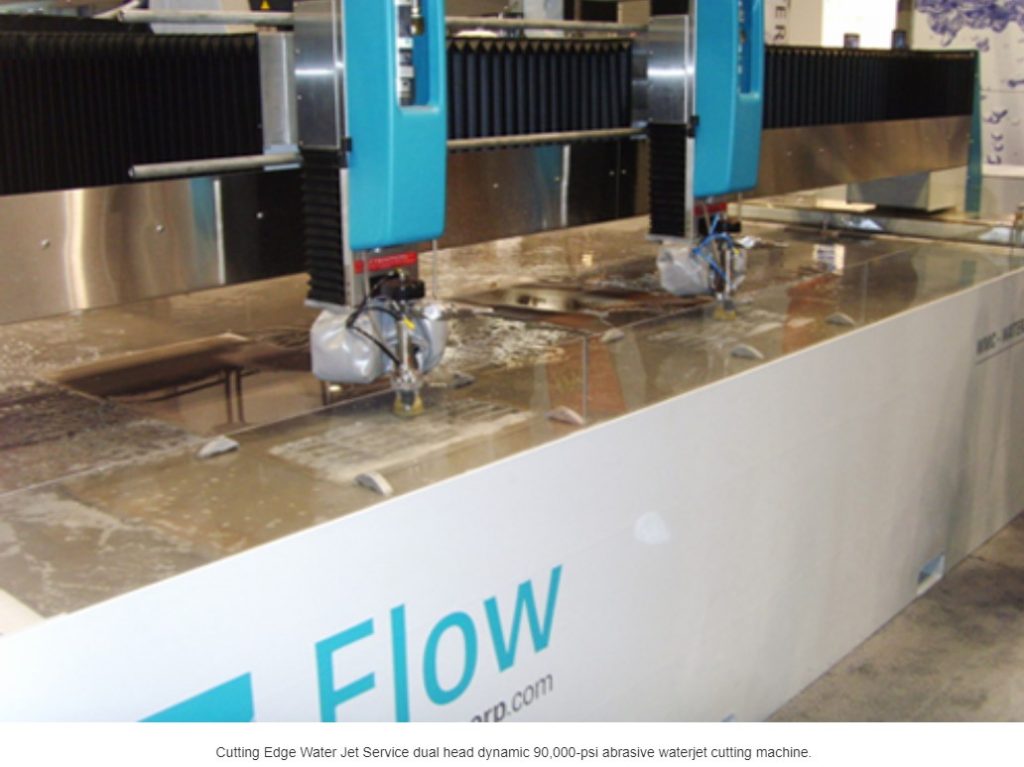 Waterjet cutting systems are much like other shape cutting systems utilizing computer controlled motion, post processing of tool paths, and multi-head configurations. Water jet machines can cut any known material including composite, laminates, plastics, rubbers, castings, forging, aluminum, stainless steels, hardened or tool steel, exotic alloys, heat sensitive materials, synthetics, and any materials that may release harmful vapors when cut using other methods. Abrasive water jet cutting will eliminate the need for machining stock or slag caused by heat processes like laser, flamecut or plasma, and will not affect material properties or temper.
Waterjet cutting systems are much like other shape cutting systems utilizing computer controlled motion, post processing of tool paths, and multi-head configurations. Water jet machines can cut any known material including composite, laminates, plastics, rubbers, castings, forging, aluminum, stainless steels, hardened or tool steel, exotic alloys, heat sensitive materials, synthetics, and any materials that may release harmful vapors when cut using other methods. Abrasive water jet cutting will eliminate the need for machining stock or slag caused by heat processes like laser, flamecut or plasma, and will not affect material properties or temper.
Waterjet cutting systems are adjustable to cut at a variety of pressures up to 90,000 psi, with or without the introduction of abrasive material. High-pressure water moving through the orifice at nearly 3,000 miles per hour provides the necessary energy for cutting soft materials or with the introduction of abrasive can cut materials approaching the hardness of diamond.
Conventional waterjet cutting systems create a natural edge taper during cutting. The faster you cut the more taper that is created, resulting in a lower shape cost (time is money), while cutting slower will minimize the amount of edge taper; the result is a higher shape cost.
Dynamic waterjet cutting uses complex algorithms to reduce edge taper by tilting cutting head during cutting up to 7 degrees per side. The resultant part will have little edge taper, while the scrap will have twice that of conventional waterjet cutting. Major advantage: faster cut speeds with controllable taper.
The waterjet industry recognizes five standard cut qualities (controlled by speed) Q1, Q2, Q3, Q4, and Q5, although cut speeds can be dialed-into any percentage between these standards. Pricing is based on assigning cut qualities to each specific shape entity, in any combination. Ra finish for a Q5 cut is typically around 80Ra. As a non-contact process, tolerances can be challenging to consistently maintain. While selecting the appropriate cut quality is important for targeting a tolerance range, other factors can negatively impact resultant tolerances/sizes, such as material stress, preliminary machining/grinding/heat treating, poor table construction, and material warpage.
Article prepared by Ron Fairchild of Cutting Edge Water Jet Service; South Beloit, Illinois. Ron has over 20 years of experience in hands-on waterjet applications. Cutting Edge Water Jet Service is a job shop provider of water jet services for all industries in the United States. They offer 90,000 psi conventional and dynamic abrasive waterjet cutting using a variety of multi-head waterjet cutting systems.
